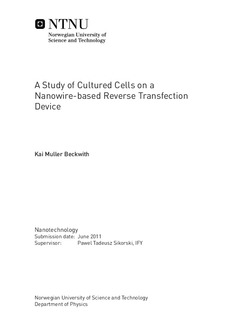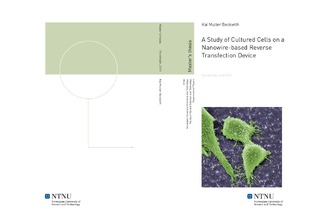| dc.description.abstract | This work builds on previous research at NTNU into the use of vertically aligned copper oxide nanowire arrays as a versatile system to deliver biomolecules into cultured adherent mammalian cells. The background for the project and previous work on the topic is presented, including a review of relevant literature on cell transfection systems, nanowire-based transfection, cell interactions with nanowires, surface functionalization strategies and details on relevant materials. Methods and results of the current work are presented and discussed. Initially, methods to study cultured cells were investigated, including various fluorescent dyes and drying procedures for electron microscopy, and optimal procedures were found. Copper oxide nanowire arrays were grown by thermal oxidation and incorporated into functional, transparent devices by polymer processing and photolithography with PMMA, PDMS and SU-8. This lead to optionally PDMS- or gold-coated nanowires protruding from an SU-8 surface patterned with wells. Surface functionalization strategies for optimal biomolecule binding were investigated, including organothiols on gold and organosilanes on glass, PDMS, SU-8 and mica. Thiols on gold were found to be challenging to study due to fluorescence quenching and substrate roughness, but aminosilanes were successfully prepared and investigated through immobilization of fluorescent quantum dots and DNA. Patterning of surface chemistry was also used to modify cell attachment and spreading, defining areas with no cell attachment or defining arrays of single cells with defined morphologies. Transparent nanowire devices displayed limited cell attachment and spreading. Numerous model samples were tested, and it was concluded that planar substrates of PMMA, PDMS and SU-8 were biocompatible, but that the patterned SU-8 structure together with a PDMS-layer induced the cell toxicity, likely due to a retainment and subsequent leakage of a process solvent. Alternative routes to produce non-toxic nanowire surfaces were found, and HeLa cells were successfully cultured and studied on such surfaces. The cells generally spread out in a way similar to flat culturing surfaces despite being penetrated by multiple nanowires. However, at high wire densities, reduced cell spreading was observed and attributed to lack of substrate contact. The HeLa cells were shown to interact with the nanowires, with cellular protrusions binding to and engulfing the nanowires regardless of nanowire surface chemistry. Preliminary experiments on delivery of a GFP-encoding plasmid showed transfection of nanowire-penetrated cells, although transfection efficiency was low. The results are compared with relevant literature, and finally future prospects of the device in delivery applications and cell microarrays are discussed. | nb_NO |

